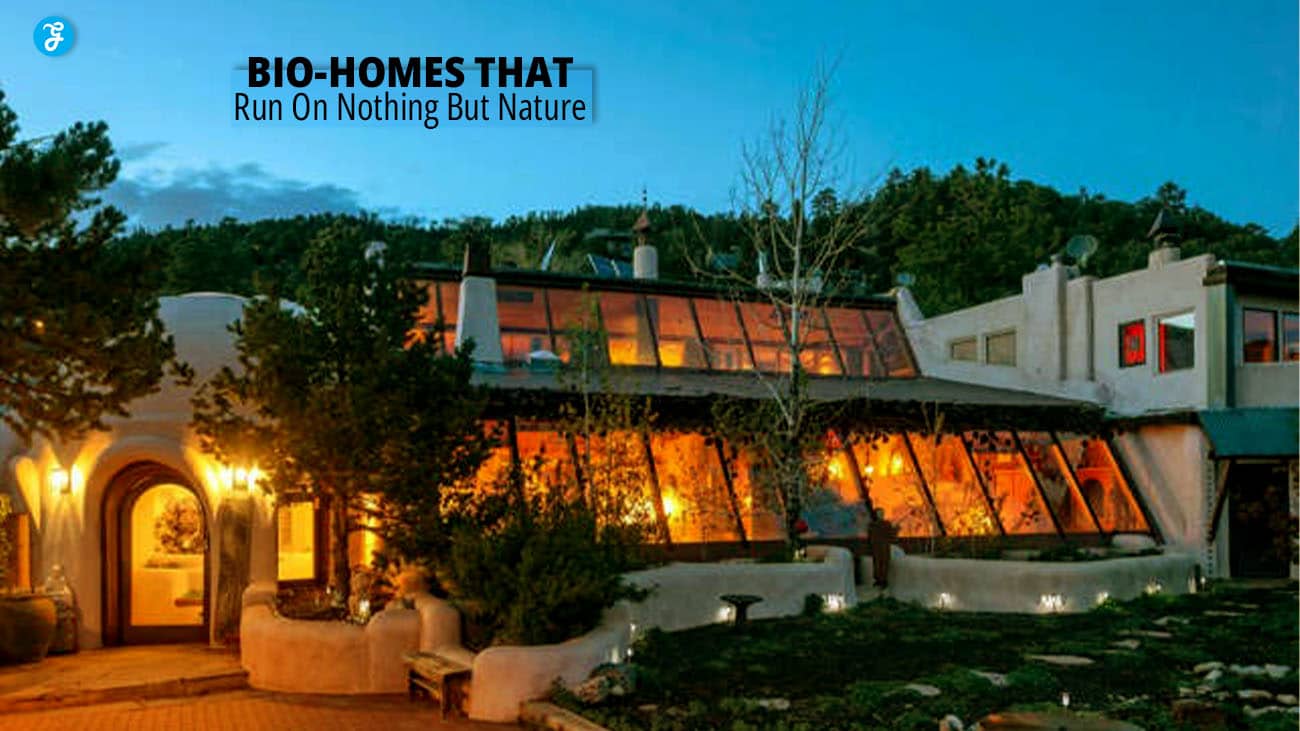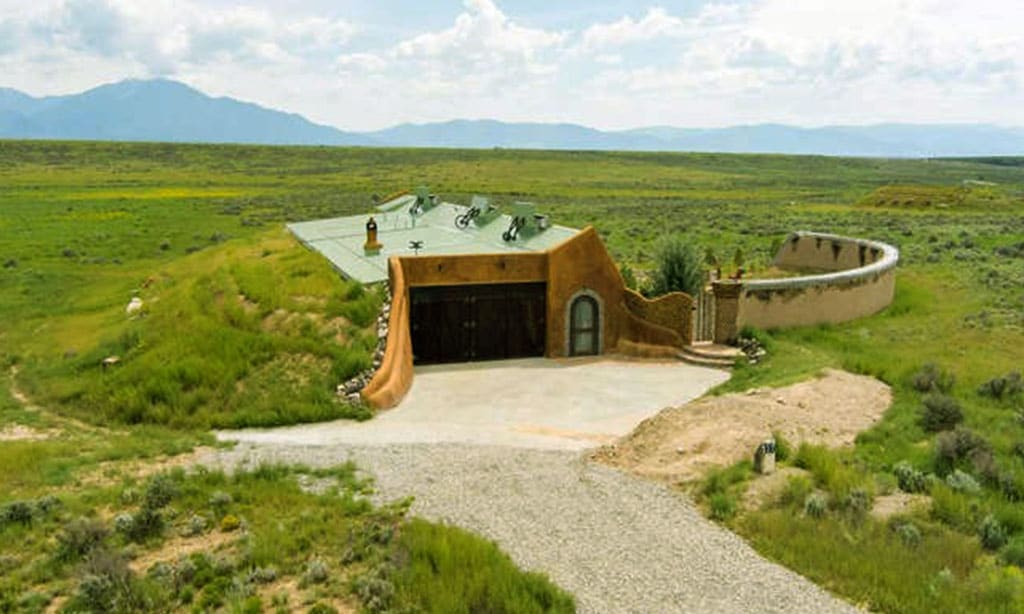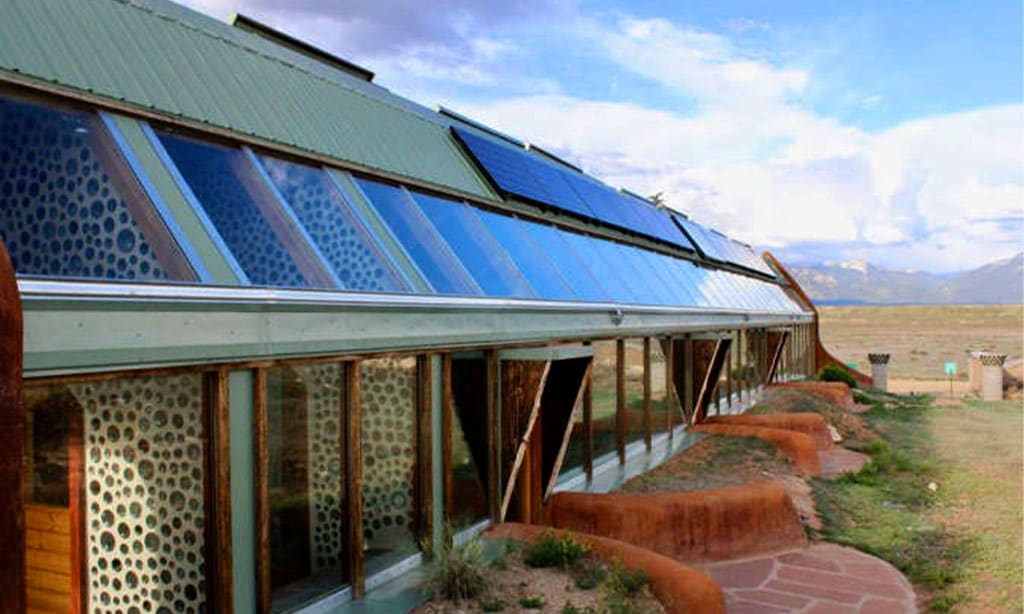Living in harmony with nature sounds like a dream. But what if you could have a home that uses only natural resources? Biohomes offer a way to live without relying on outside energy or water sources.
These unique houses run solely on what nature provides, from sunlight to rainwater. They’re built with eco-friendly materials and intelligent designs that work with the environment.
You might be surprised at how cozy and contemporary these homes can be. Let’s explore some fantastic bio-homes showing that zero-cost, nature-powered living is possible.
1. Solar-Powered Water Heaters
Solar-powered water heaters are a great way to save money and energy in your home. These systems use the sun’s power to heat water for your daily needs.
How do they work? Solar panels on your roof collect sunlight. This energy then heats water in a tank. You can use this hot water for showers, washing dishes, and more.
A solar water heater ranges from $2,000 to $5,000. Installation adds another $1,000 to $3,000. While this may seem high, it can save you money over time.
Many homeowners see a boost in their property value with these systems. Research shows homes with solar water heaters can be worth 3% to 4% more.
There’s also good news about tax breaks. You can get a federal tax credit for 30% of the cost when you install a solar water heater.
One thing to keep in mind is that these systems work best with plenty of sunlight. On cloudy days or at night, you might need a backup heat source.
Despite this, solar water heaters are a smart choice for many homes. They cut energy bills and help the environment. If you want to save money and go green, consider adding one to your house.
2. Rainwater Harvesting Systems
Rainwater harvesting systems are an intelligent way to use nature’s gift. These setups collect rain from your roof and store it for later use. You can use this water for many things around your home.
The main parts of a rainwater harvesting system are simple. You need gutters to catch the rain, pipes to move it, and a tank to store it. Some systems also have filters to clean the water.
Rain barrels are a good starting point if you’re new to this. They’re easy to set up and don’t cost much. For more significant needs, you might want a larger tank or cistern.
You can use harvested rainwater in many ways. It’s great for watering your garden or lawn. You can also use it to flush toilets or wash your car. In some cases, with proper treatment, you can even drink it.
These systems help you save money on water bills. They also reduce the strain on public water supplies. This is especially helpful in dry areas or during droughts.
By collecting rainwater, you’re also helping the environment. You’re using a natural resource that would otherwise go to waste. This can help prevent flooding and erosion in your area.
Setting up a rainwater harvesting system can be a fun project. You can do it yourself or get help from professionals. Either way, you’ll be taking a big step towards sustainable living.
3. Living Green Roofs
Living green roofs are a vital feature of many bio-homes. These roofs are covered with plants and vegetation, turning your home’s top into a mini garden.
Green roofs help keep your house cool in summer and warm in winter. They act like natural insulation, saving you money on heating and cooling bills.
Plants on your roof can clean the air around your home. They trap dust and filter out pollutants, making the air fresher and healthier.
These roofs also help manage rainwater. They soak up rain, reducing runoff and easing the strain on drainage systems.
Green roofs can last longer than regular roofs. The plants protect the roof materials from sun damage and temperature changes.
You can grow food on your living roof. Herbs, vegetables, and even small fruit trees can thrive up there, giving you fresh produce at home.
Wildlife loves green roofs, too. Birds, butterflies, and bees can find food and shelter in your rooftop garden.
Living roofs can make your home look beautiful. They blend your house with nature, creating a unique and eye-catching appearance.
You don’t need a flat roof for plants. Sloped roofs can support green life, too, with unique systems to hold soil and plants in place.
Green roofs can boost your property value. Many people find homes with living roofs more appealing, which could mean a higher resale price.
4. Composting Toilets
Composting toilets is a game-changer for eco-friendly homes. They turn waste into valuable compost without using water or chemicals. You’ll find these toilets in many off-grid homes and tiny houses.
How do they work? Composting toilets separates liquid and solid waste. The solid waste is mixed with materials like sawdust or coconut coir. This helps it break down faster and controls odors.
You have several options when choosing a composting toilet. Nature’s Head is a famous brand known for its reliability. The Separett Villa 9215 is another top choice, praised for its odor control.
The Sun-Mar GTG Electric model offers good value for those on a budget. If you need a portable option, consider the Boxio camping toilet. It’s great for outdoor adventures or small spaces.
Composting toilets need some care to work well. You’ll need to empty them regularly and add dry materials. But the payoff is big – you save water and create helpful compost for your garden.
These toilets are more than just a green choice. They give you freedom from traditional plumbing systems. This makes them perfect for remote locations or homes aiming for complete self-sufficiency.
5. Natural Ventilation Systems
Natural ventilation systems are critical to zero-cost living in bio-homes. These systems use the wind and temperature differences to move air through a building. You don’t need fancy machines or electricity to keep your home cool and fresh.
Intelligent design is the secret. Bio-homes often have windows on opposite sides. This lets air flow freely from one end to the other. Tall ceilings and roof vents help, too. They create a “chimney effect” that pulls hot air up and out.
Some bio-homes use underground tubes called earth tubes. These pipes bring cool air from deep in the ground into your home. As the air travels through the tubes, it naturally cools down.
Thermal mass is another clever trick. Thick walls made of earth or stone absorb heat during the day. At night, they slowly release this heat, keeping your home warm.
Plants play a significant role, too. Trees and shrubs around your home can guide breezes and provide shade. Inside, houseplants help clean the air and add moisture.
You can keep your home comfortable all year round using these natural methods. No air conditioners or heaters are needed!
6. Earth-Sheltered Homes
Earth-sheltered homes are a clever way to live with nature. These homes use the ground for insulation and protection. You can find them built into hillsides or covered with soil.
These houses stay cool in summer and warm in winter. This means you use less energy for heating and cooling. Your bills go down, and you help the planet, too.
Earth-sheltered homes come in different styles. Some have one side open to let in light. Others are fully underground with skylights. You can choose what works best for you.
Building these homes takes careful planning. You need to think about water drainage and airflow. But once built, they last a long time and require little upkeep.
Living in an earth-sheltered home feels cozy and safe. You’re snug inside while nature surrounds you. It’s like having a secret hideout that’s good for the environment.
These homes blend into the landscape. They don’t stick out or disturb the natural view. You can even grow plants on the roof to make it look like part of the hill.
Earth-sheltered homes are burdensome. They stand up well to storms and extreme weather. This makes them an intelligent choice in areas with harsh climates.
7. Passive Solar Heating
Passive solar heating is a smart way to use the sun’s energy to warm your home. It doesn’t need fancy equipment or high-tech gadgets. Instead, it relies on clever design and natural materials.
The key is to catch sunlight through south-facing windows. These windows let in warmth during winter when the sun is low. In summer, overhangs block the high sun to keep your home cool.
Materials like concrete floors or brick walls soak up heat during the day. At night, they slowly release this warmth, keeping you cozy. This is called thermal mass.
Sound insulation is crucial, too. It traps the heat inside, so you stay warm even when cold outside. Thick walls, double-pane windows, and proper sealing all help.
You can boost the effect with reflective surfaces. These bounce sunlight deeper into your home, spreading warmth more evenly.
Passive solar homes can cut heating costs by up to 40%. That’s a significant saving on your energy bills. Plus, it’s great for the planet since you use less fuel.
Remember, every home is different. The best design depends on your location, climate, and building site. But with some planning, you can harness the sun’s power to keep your home cozy and eco-friendly.
8. Gray Water Recycling Systems
Gray water recycling systems can help you save money and water in your bio-home. These systems reuse water from sinks, showers, and washing machines for other purposes like watering plants or flushing toilets.
A basic system can cost as little as $100-$300 for a single appliance. More complex whole-house systems range from $1,000 to $5,000 on average. The price depends on the size and capabilities you need.
One popular option is the Hydraloop system. It recycles water for toilets and laundry with minimal maintenance. The recycled water stays at a comfortable 68°F, saving water and energy.
A Hydraloop can save about 600 kWh of electricity per year for a family of four. That’s equal to 7,339 MJ of primary energy savings annually.
When planning your gray water system, consider how much water you use. Consider the size of your garden and your local climate, too. This will help you choose the right system for your needs.
Gray water recycling is a great way to reduce water use and utility bills. It’s an essential part of creating a sustainable, nature-powered home.
9. Thermal Mass Flooring
Thermal mass flooring is an intelligent choice for zero-cost living. It helps keep your home comfortable without using energy. This type of floor absorbs heat during the day and releases it at night.
Concrete is a popular option for thermal mass floors. It’s durable and can be polished for a sleek look. You can add color or patterns to make it more attractive.
Stone is another excellent choice. Materials like slate or marble work well. They’re natural and long-lasting. Plus, they add a touch of elegance to your home.
Tile over a concrete slab is also effective. It combines the thermal benefits of concrete with the beauty of tile. You can choose from many colors and styles to match your decor.
These floors work best with passive solar design. Large south-facing windows let in sunlight to warm the floor. The floor then slowly releases heat, keeping your home cozy.
For the best results, pair thermal mass flooring with good insulation. This keeps the warmth inside where you want it. It also helps your floor stay cool in summer.
10. Garden Rooftops
Garden rooftops are a great way to make your home more eco-friendly. These living roofs cover the top of your house with plants and greenery. They help you save money on energy bills and connect with nature.
You can grow fruits, veggies, and herbs right on your roof. This gives you fresh food without needing a yard. Garden rooftops also make your home look pretty from above.
These green roofs keep your house cooler in summer and warmer in winter. They act like natural insulation. This means you use less energy for heating and cooling.
Garden rooftops also help the environment. They catch rainwater, which reduces flooding. They also give birds and bugs a place to live in the city.
You can make your garden rooftop as big or small as you want. Even a small patch of plants can make a difference. Some people cover their whole roof with grass and flowers.
To start a garden rooftop, you must ensure your roof is strong enough. Then, you add layers of waterproof material and soil. After that, you can plant whatever you like.
Principles of Bio-Homes
Bio-homes blend nature with intelligent design. They use the environment to create good living spaces for you and the planet.
Biophilic Design
Biophilic design brings nature indoors. It uses natural materials, plants, and lots of sunlight. Wood, stone, and bamboo are common in bio-homes. Large windows let in daylight and give views of the outdoors. Indoor plants clean the air and make spaces feel alive.
Colors in biohomes often match nature. Think greens, browns, and blues. Shapes and patterns copy what you see outside. Curved lines and leaf-like forms are famous. Water features like small fountains add a calming touch.
Bio-homes also focus on airflow. Good ventilation keeps the air fresh. Some homes use unique air-cleaning systems. These remove harmful particles and boost your health.
Sustainability and Self-Sufficiency
Biohomes aim to work with nature, not against it. They use renewable energy sources like solar panels and wind turbines. This cuts down on power bills and helps the planet.
Many bio-homes collect rainwater. They use it for watering plants or flushing toilets. Some even clean it for drinking. Greywater systems reuse water from sinks and showers.
Gardens are a big part of bio-homes. They grow food and support local wildlife. Some homes have green roofs covered in plants. These help keep the house cool and give a home to birds and insects.
Biohomes often use recycled or local materials. This cuts down on waste and transportation costs. Innovative design makes the most of space and natural light. It reduces the need for heating and cooling.
Natural Building Materials
Natural building materials offer eco-friendly options for sustainable homes. These materials come from renewable sources and have a low environmental impact.
Earth and Clay
Earth and clay are versatile building materials that have been used for centuries. Adobe bricks are made from soil mixed with water and sometimes straw. They’re dried in the sun, creating strong blocks for walls.
Rammed earth is another technique using packed soil. Builders create walls by compressing layers of damp earth in forms. This method produces sturdy structures that can last for generations.
Cob is a mixture of clay, sand, and straw. To create walls and other structures, it is hand-molded. Cob buildings are known for their unique, organic shapes.
These earth-based materials have excellent insulating properties. They keep homes cool in summer and warm in winter, reducing energy costs.
Bamboo and Timber
Bamboo and timber are renewable resources that make excellent building materials. Bamboo proliferates and is incredibly strong. It’s used for framing, flooring, and even plumbing pipes.
You can use bamboo to build entire houses. In some parts of Asia, bamboo scaffolding is standard on construction sites.
Timber from sustainably managed forests is another good choice. Wood is versatile and can be used for framing, siding, and flooring.
Cross-laminated timber (CLT) is gaining popularity. Gluing layers make it of wood at right angles. CLT panels are strong enough to build multi-story buildings.
Both bamboo and timber store carbon, helping to fight climate change. They also create a warm, natural feel inside homes.
Energy Solutions
Bio-homes use clean energy sources to power themselves without harming nature. These solutions help people live cheaply and protect the planet.
Solar Power
Solar panels turn sunlight into electricity for bio-homes. You can put them on roofs or yards to catch the sun’s rays. Modern panels work even on cloudy days. They store extra power in batteries for nighttime use.
Solar systems need little upkeep. You just clean the panels sometimes. They last about 25-30 years. The cost of solar keeps dropping, making it more affordable.
Many bio-homes use solar water heaters, too. These heat water directly with sunlight. It cuts down on electricity use for hot showers and washing.
Wind Energy
Wind turbines make power from moving air. You can install small ones for a single home. They work best in open, windy areas.
Turbines come in different sizes. Vertical axis models are suitable for homes. They’re quieter and work in changing wind directions.
Wind power is spotless. It makes no pollution when running. The initial cost can be high, but prices are falling.
You can combine wind and solar for steady power. When it’s not sunny, it’s often windy. This mix helps bio-homes stay off the grid year-round.
Final thoughts
Bio-homes present a revolutionary way to embrace zero-cost living by harnessing nature’s power. With innovative designs and eco-friendly technologies like solar water heaters, rainwater harvesting, living green roofs, and natural ventilation systems, these homes offer a self-sufficient and sustainable lifestyle.
They minimize the need for external energy sources while maximizing comfort, efficiency, and environmental responsibility.
By integrating passive solar heating, thermal mass flooring, and garden rooftops, bio-homes prove that living in harmony with nature is not only possible but also practical and affordable.
As more people adopt these solutions, the dream of living off-grid and reducing environmental impact becomes a reality. Zero-cost living isn’t just an ideal; it’s the future of housing, blending sustainability with modern comfort.












































